Patrick Swanson has been restoring a Harrison County prairie.
Over Memorial Day weekend this year, I joined the third installment of the LoHi Trek, a multi-day hike through the Loess Hills organized by Golden Hills Resource Conservation and Development and other partners.
I joined the inaugural LoHi Trek in 2021 through Monona County, and offered my reflection on that journey in an earlier Bleeding Heartland post.
I missed last year’s trek and the follow-up “mini LoHi” hike in the fall. When the organizers announced that this year’s hike would be traversing the northern reaches of the Loess Hills in Plymouth and Woodbury Counties, visiting areas I hadn’t seen before, I jumped at the opportunity.
As it turned out, the hike was a reunion of sorts. Many of the attendees had gone on one or more of the previous hikes—one star trekker had been on all of them! I really enjoyed catching up with those I met on the first hike and getting to know some my new fellow travelers. Golden Hills RC&D has already posted a nice summary of each day’s hike and its associated activities, so I will focus mainly on my own descriptions and impressions of the journey.
The first day’s hike took the group through The Nature Conservancy’s Broken Kettle Grasslands, including part of a large pasture grazed by a small herd of bison, which is normally closed to the public. Perhaps for the good of both parties, the bison were elsewhere in the paddock as we came through, granting me some time to leisurely observe how the bison seem to use this landscape.
I’ve hiked in many parts of the Loess Hills, and one distinctive feature of this place was the presence of bison wallows on several hillsides. These depressions offer a habitat niche for plants and animals that prefer disturbance and bare soil.
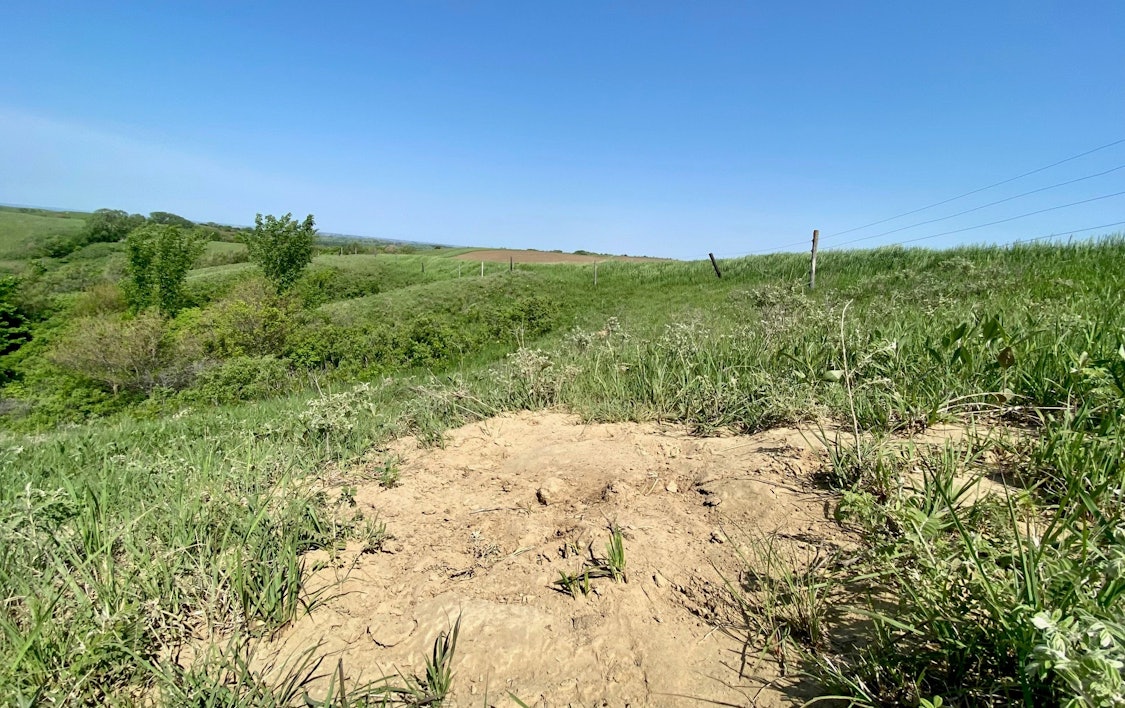
Another attention grabber was the presence of scattered “buffalo chips,” which are a bountiful natural food source for invertebrates like dung beetles. Thus, large herbivores like bison play a key role in creating and sustaining different food webs in prairie habitats.

What I didn’t fully appreciate was the idea, expressed by The Nature Conservancy’s Director of Stewardship Scott Moats, that nutrients, like water, flow downhill, gradually depleting soil productivity on the high ground. But here the bison help bring those nutrients back uphill by depositing their waste on the ridge lines.
I recalled the lone bison we passed by earlier on our drive to the trail head, greeting the sunrise casually chewing grass on a hill crest, and saw that activity in a new light: namely, as moving nutrients from valleys to peaks, from “Lo” to “Hi.”
Upon exiting the bison pasture, I chatted more with Scott, asking him how bison and cattle used the preserve’s stock pond differently. He told me when cattle were on the land, they tended to wallow in the water on hot days, trampling the vegetation and muddying the water. By contrast, bison come down to the pond less frequently in hot weather. They get in, maybe swim across, get out, shake off, and go back to grazing. As a result, he said the water clarity has dramatically improved since the bison were introduced to the preserve.
By managing the bison numbers carefully, overgrazing is avoided. As a result, the prairie here has a rich variety of plants. Among the flowers in bloom was Prairie Redroot (Ceanothus herbaceous), shown here:
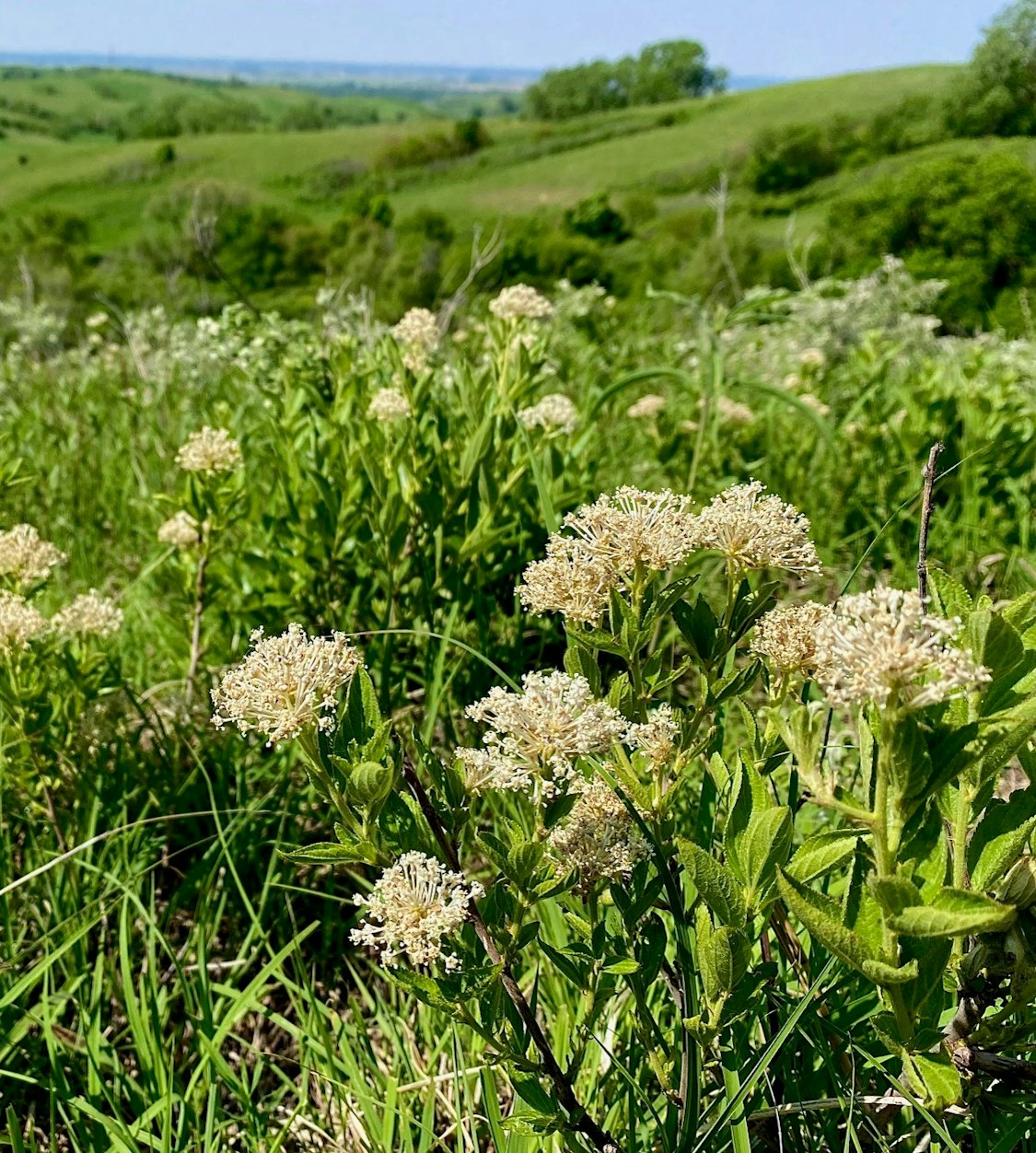
We also saw a species of penstemon that some of us initially thought was Foxglove Beardtongue, but it didn’t seem like a good match to specimens we had seen before. These were shorter, hairier, and had narrower serrated leaves. The Minnesota Wildflowers website’s description of Foxglove Beardtongue pointed me to a plausible alternative: White Beardtongue (Penstemon albidus), a Great Plains species that reaches the eastern extent of its range in far northwestern Iowa.
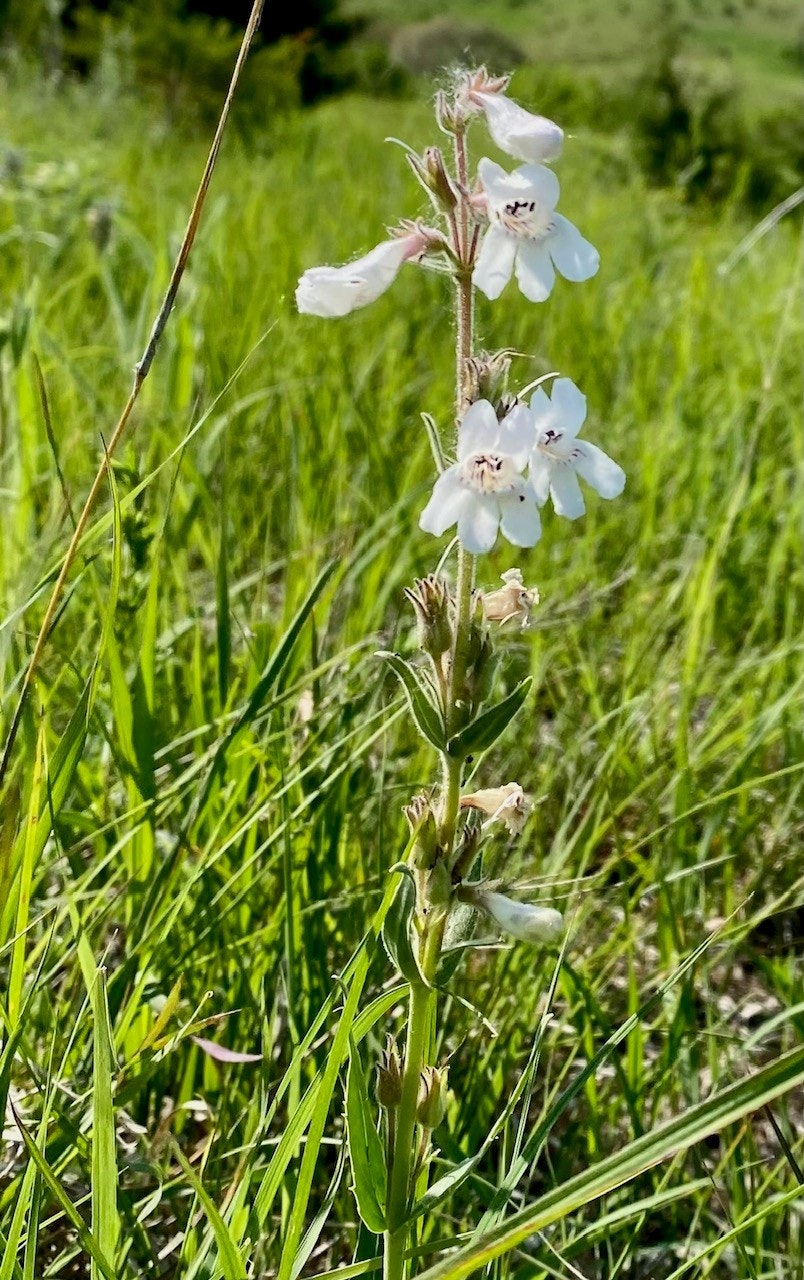
Yucca (Yucca glauca), locally common in the Loess Hills, was not yet blooming here, but offered striking poses in floral anticipation.
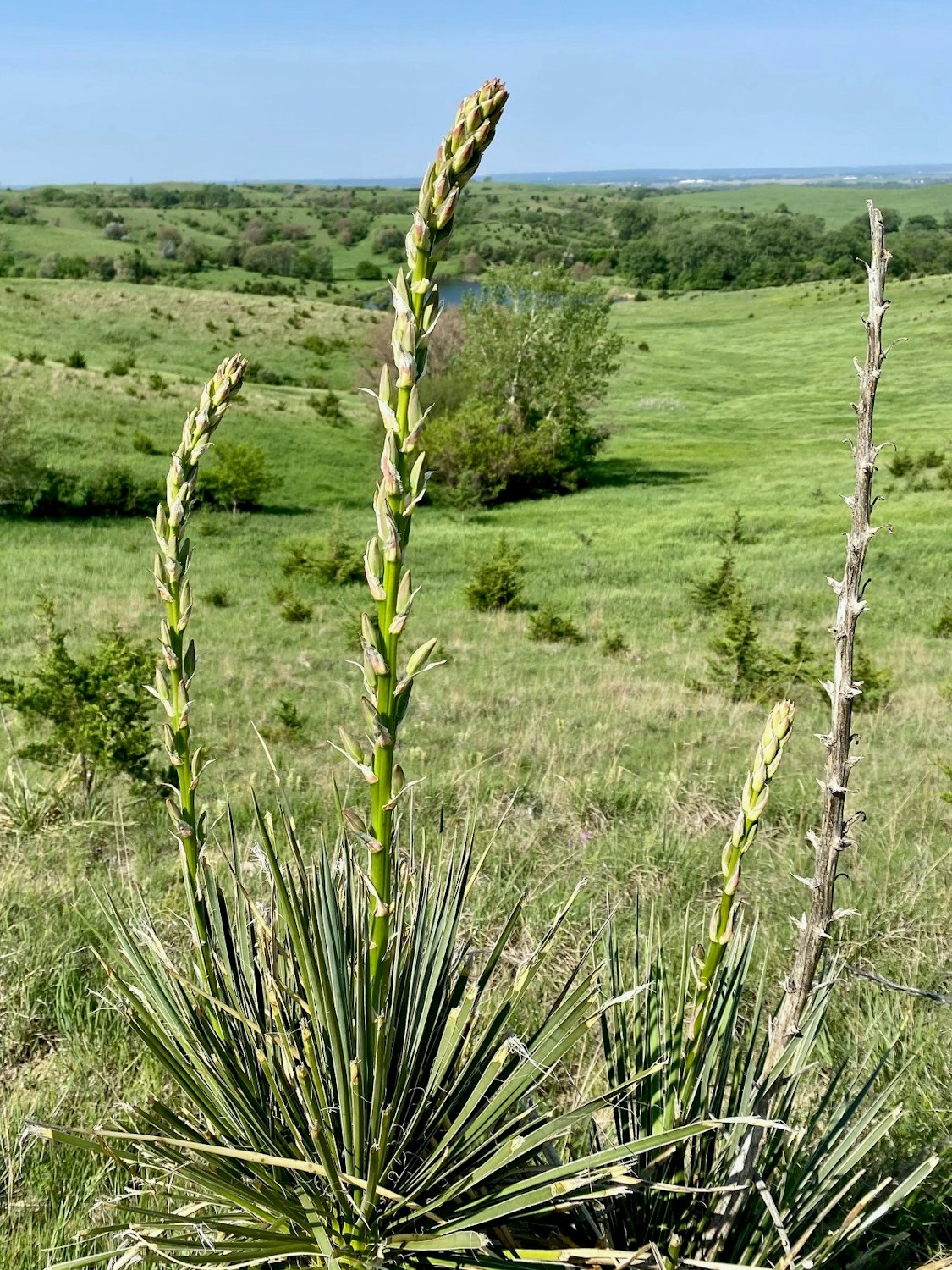
The second day took us through Five Ridge Prairie State Preserve, with its stunning overlook of the Big Sioux River.
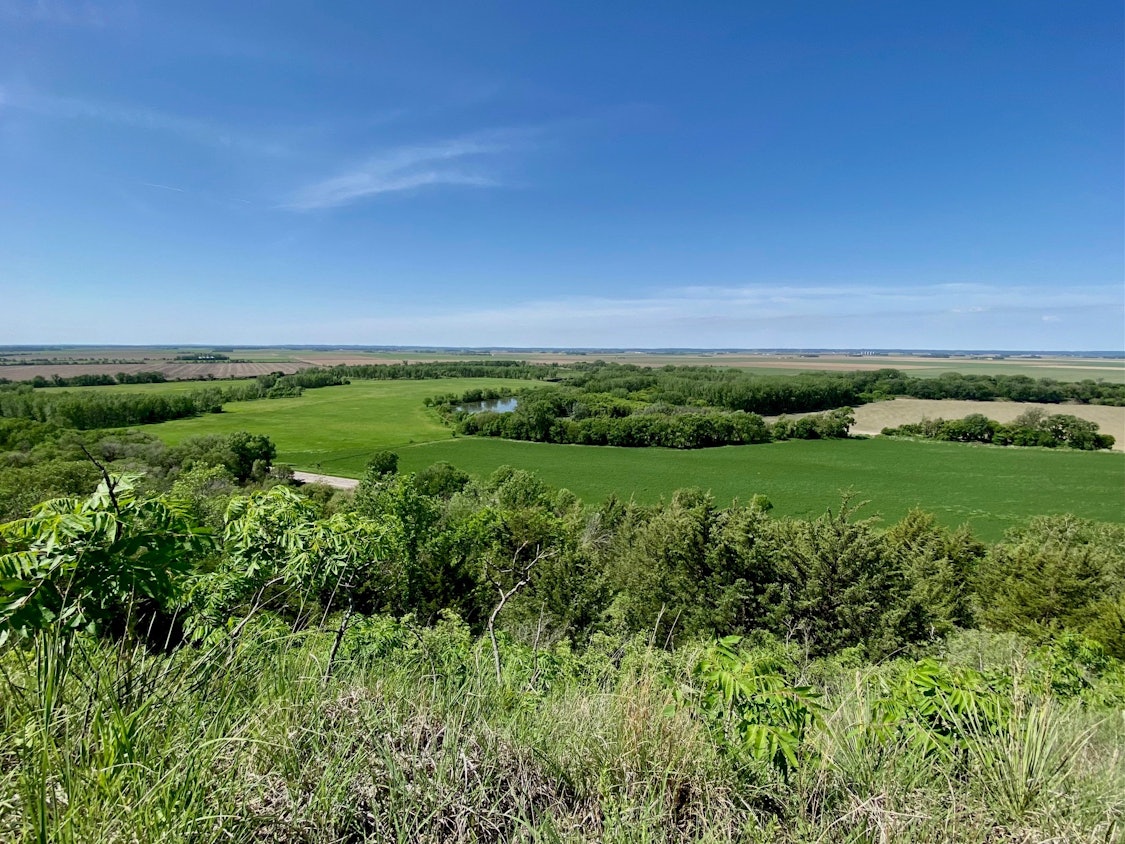
Along our way, I spied a Scarlet Gaura (Oenothera suffrutescens) growing on the trail, begging for some attention, so of course I obliged.
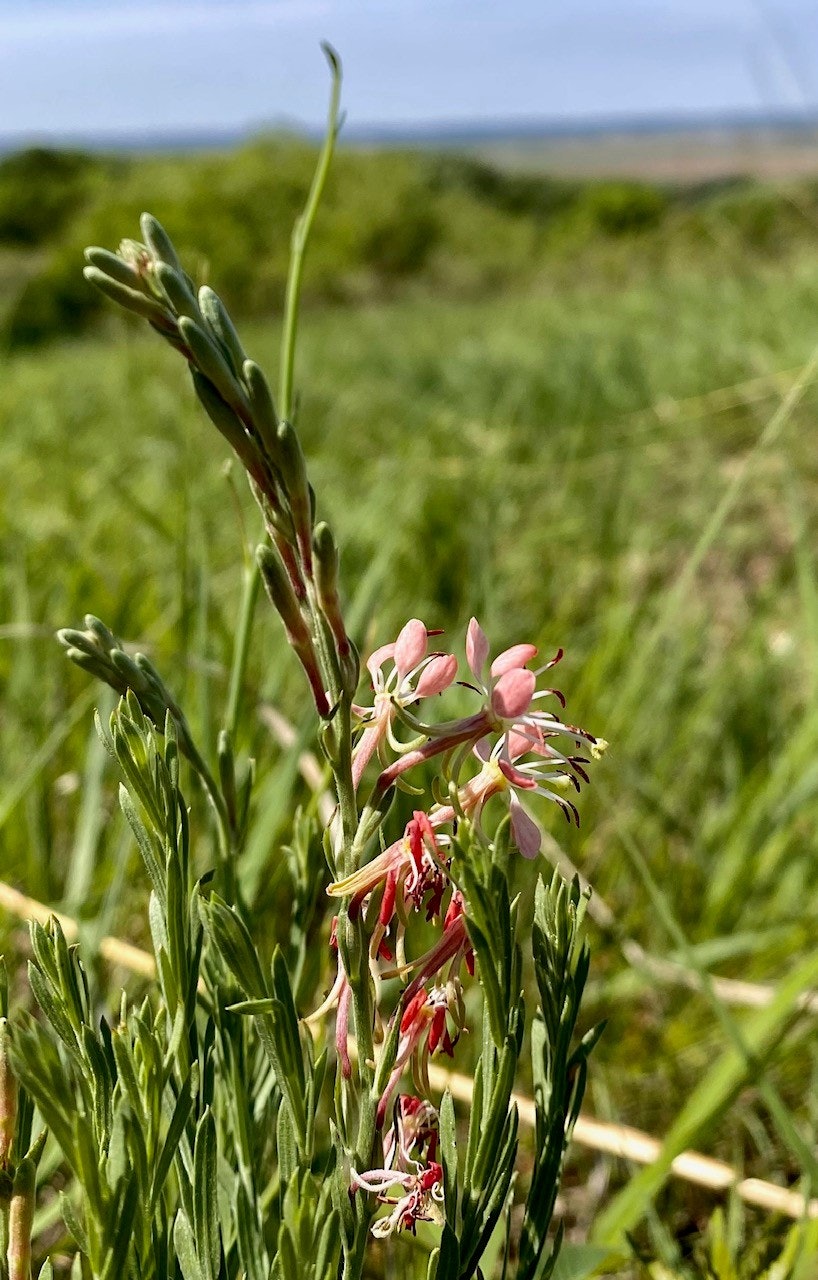
Further on, I stopped to enjoy my lunch off a side trail under the shade of a bur oak, sitting alongside a Prairie Turnip (Pediomelum esculentum) leaning sunward.
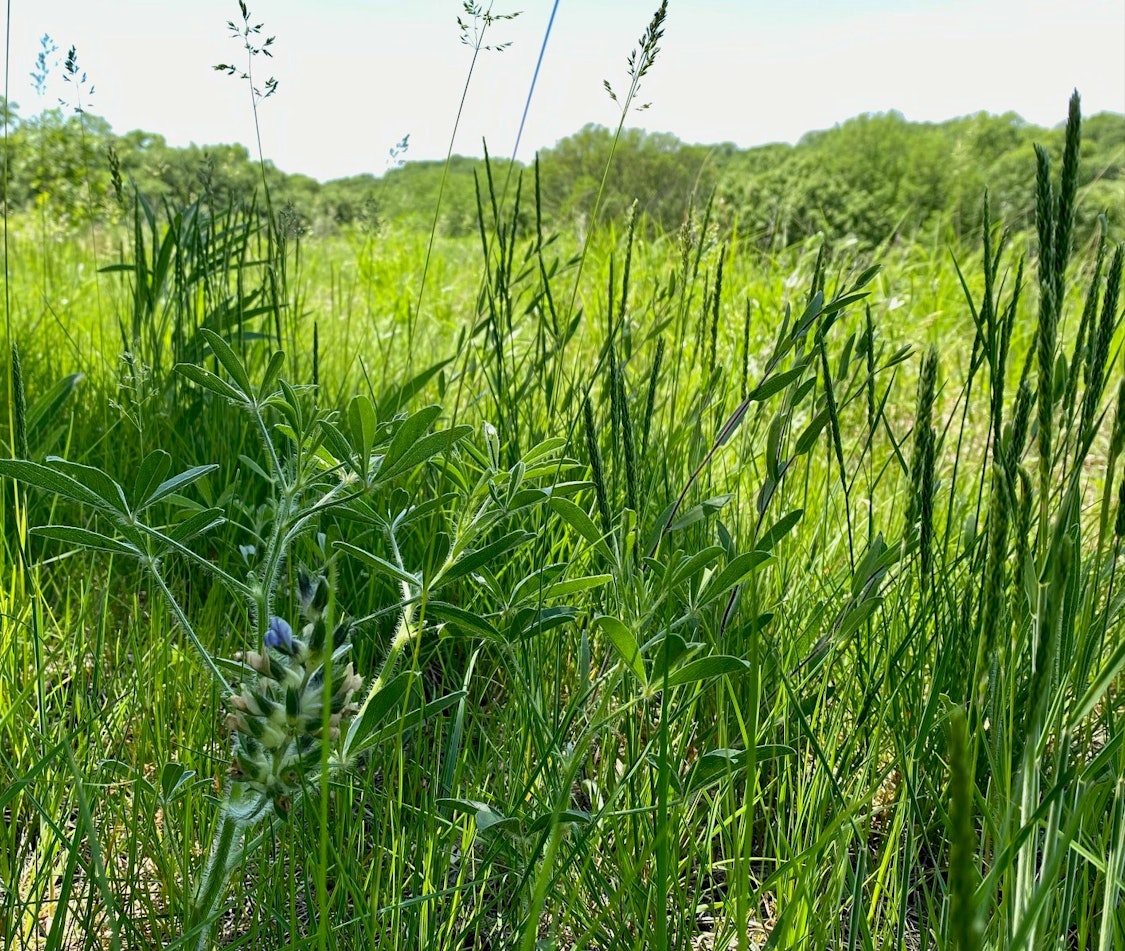
After lunch, the trail led though woodland, later emerging onto an old bulldozer cut, where Tall Cinquefoil (Drymocallis arguta) stretched out from the sidewall.

Further along this path, I noticed a little brown bird flush from the other side of the trail, which signaled to me a likely nest in that area. Sure enough, under an overhanging clump of vegetation, was the woven grass nest of a field sparrow containing three eggs. Not wanting to linger near the nest, I took a quick picture of the site to show its context.
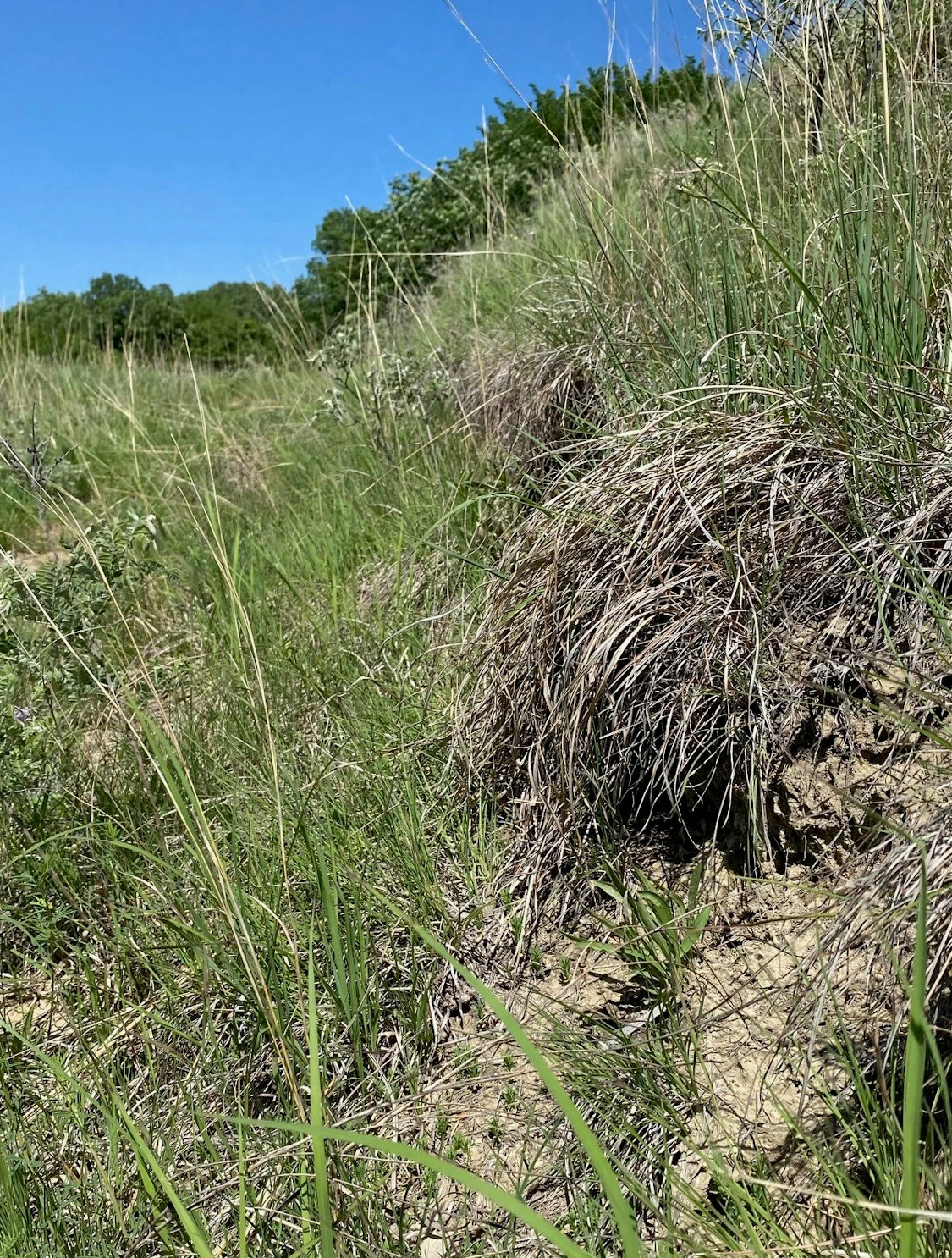
Moving on, I eventually passed through a high-quality prairie, reconstructed by the hosts of our evening meal, Bill and Dotty Zales. Bill is retired botany professor, and his passion and former profession show through on this landscape.
I would later learn from him that returning these former pastures back to prairie involved the painstaking collection and sowing of native seed, using a three year rotation of haying, burning, and rest, over a period of about 20 years, to reach its present state. The success of his approach is underscored by the presence of so many native wildflowers here, like Large-Flowered Beardtongue (Penstemon grandiflorus). What a remarkable and inspiring achievement!
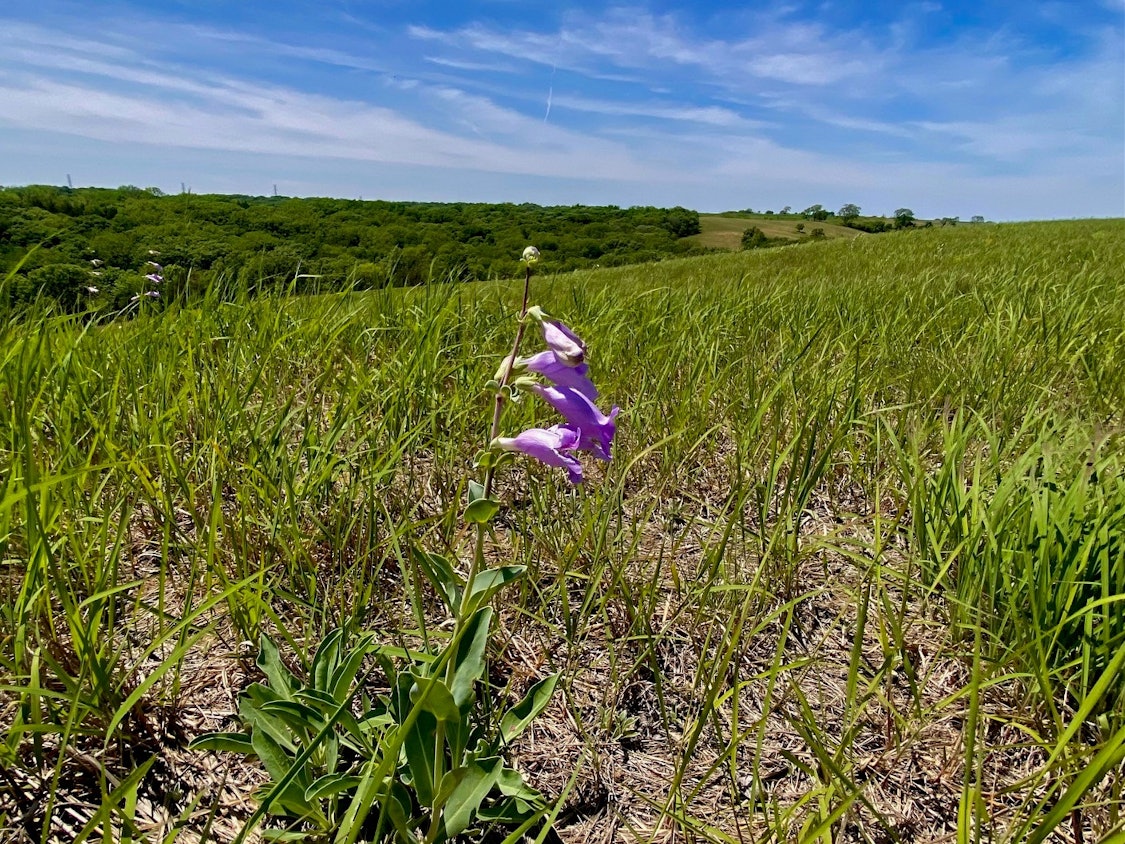
As if that were not enough, our hosts are also accomplished home-brewers. I especially enjoyed their apple and pear hard cider, made with fruit from their own orchard. Can’t get any more local than that!
The third day’s hike led through the Heendah Hills State Recreation Area – Stone State Park complex, which included a stretch of more recently acquired land that provides a key corridor linking these two areas, known as the Hummel tract. Walking through this section admittedly left me grieving for the land, as the area closest to Highway 12 was infested with invasive species and blotched with many refuse piles containing all manner of cast-off items, such as old bedsprings and a broken safe.

Further on, as the road cut through the ridge, I could see the impact of water cleaving through bare soil, exposing a gaping chasm in the earth.

And yet…and yet…I saw reasons for hope here. Already, tons of junk had been hauled out for scrap and recycling, and more is being removed. Further along the old road, cedars and other invading trees had been cleared from the hillsides and piled for later burning.
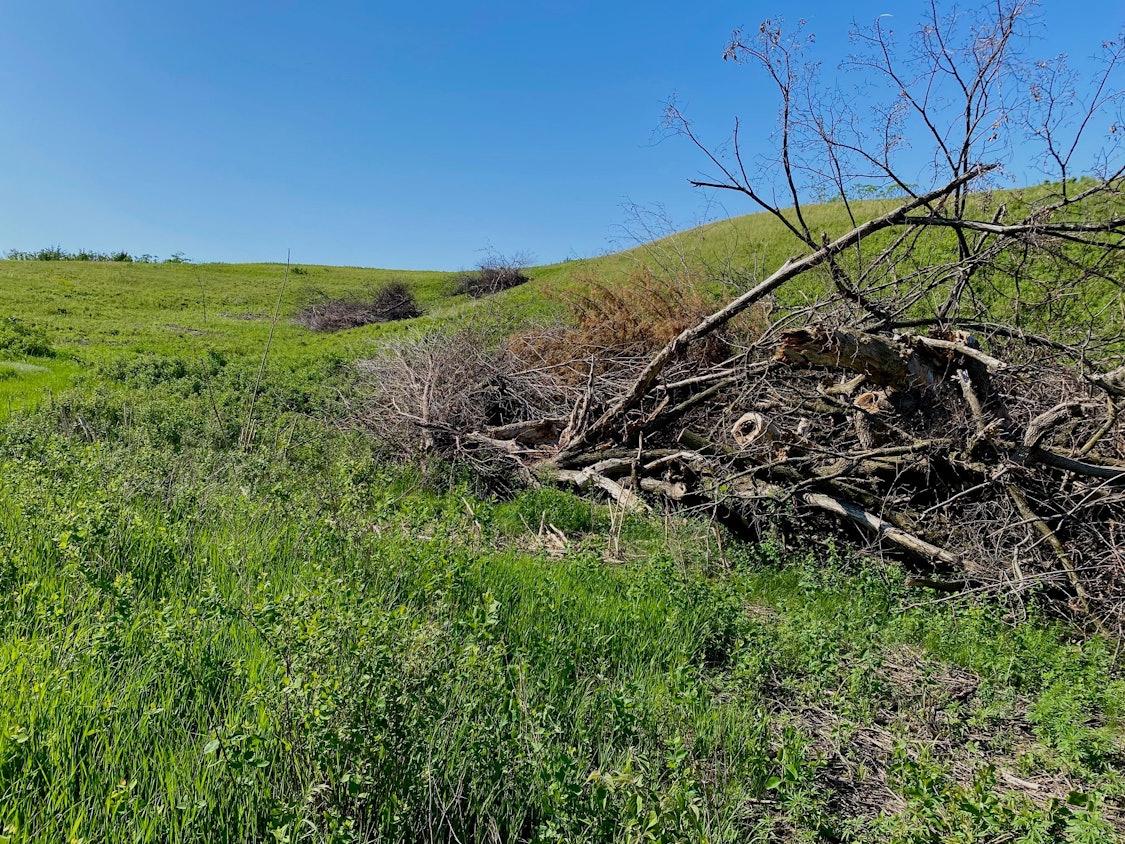
Past the ridge cut, I was greeted by Locoweed (Oxytropis lambertii) and native grasses with interspersed small cedars on virgin Loess slopes.
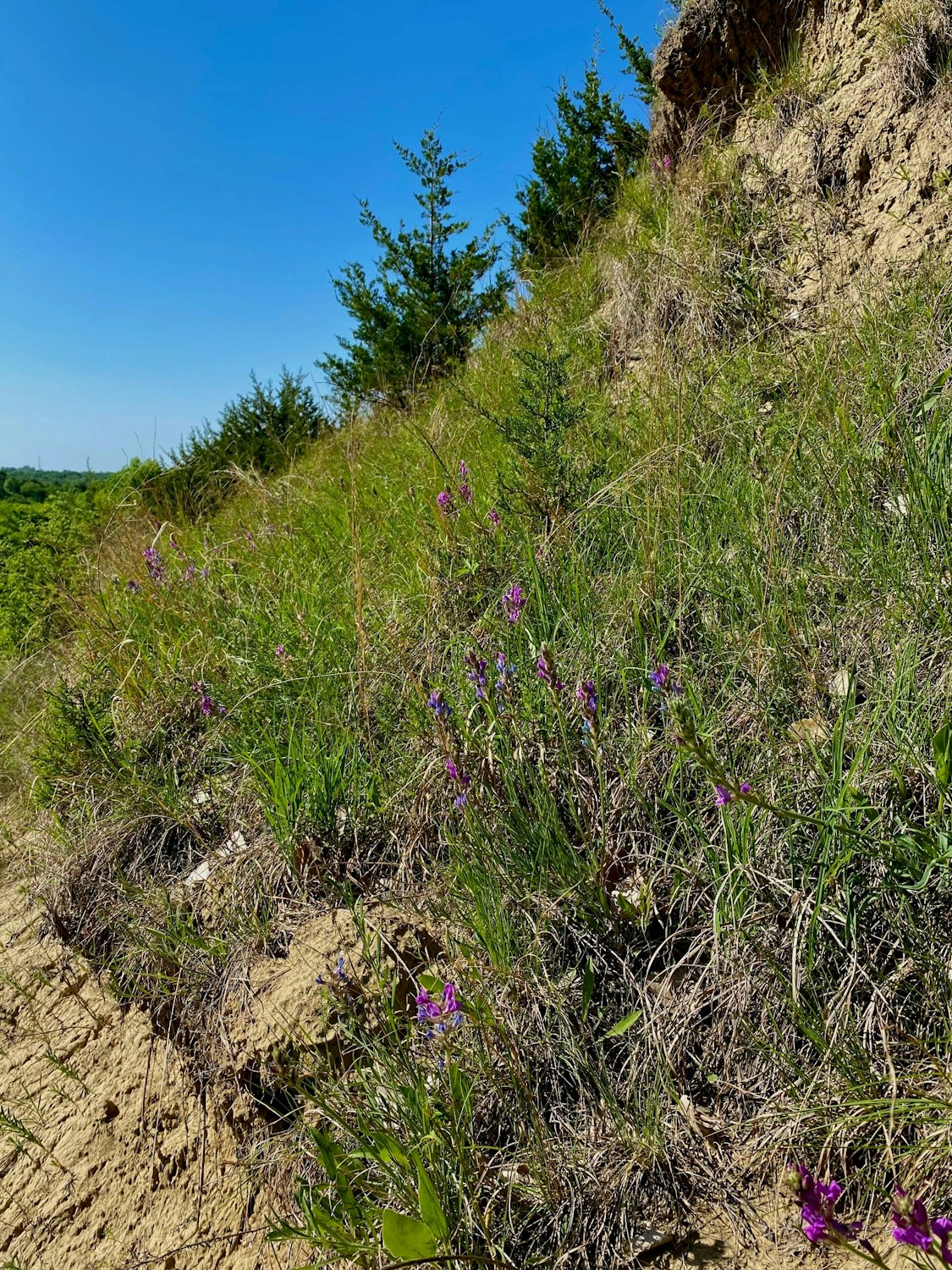
When eventually applied to these hills, prescribed fire will help rejuvenate the prairie flora and suppress the invasive species. Most important, travelers of all kinds will find a safe, unbroken passage across this part of the Loess Hills.
As we hiked our way into Stone State Park, clambering over a barbed wire fence and bushwhacking up and down brush-covered hills, the grasslands transitioned to mostly bur oak forest, giving welcome shade, but also diminishing the refreshing breeze.
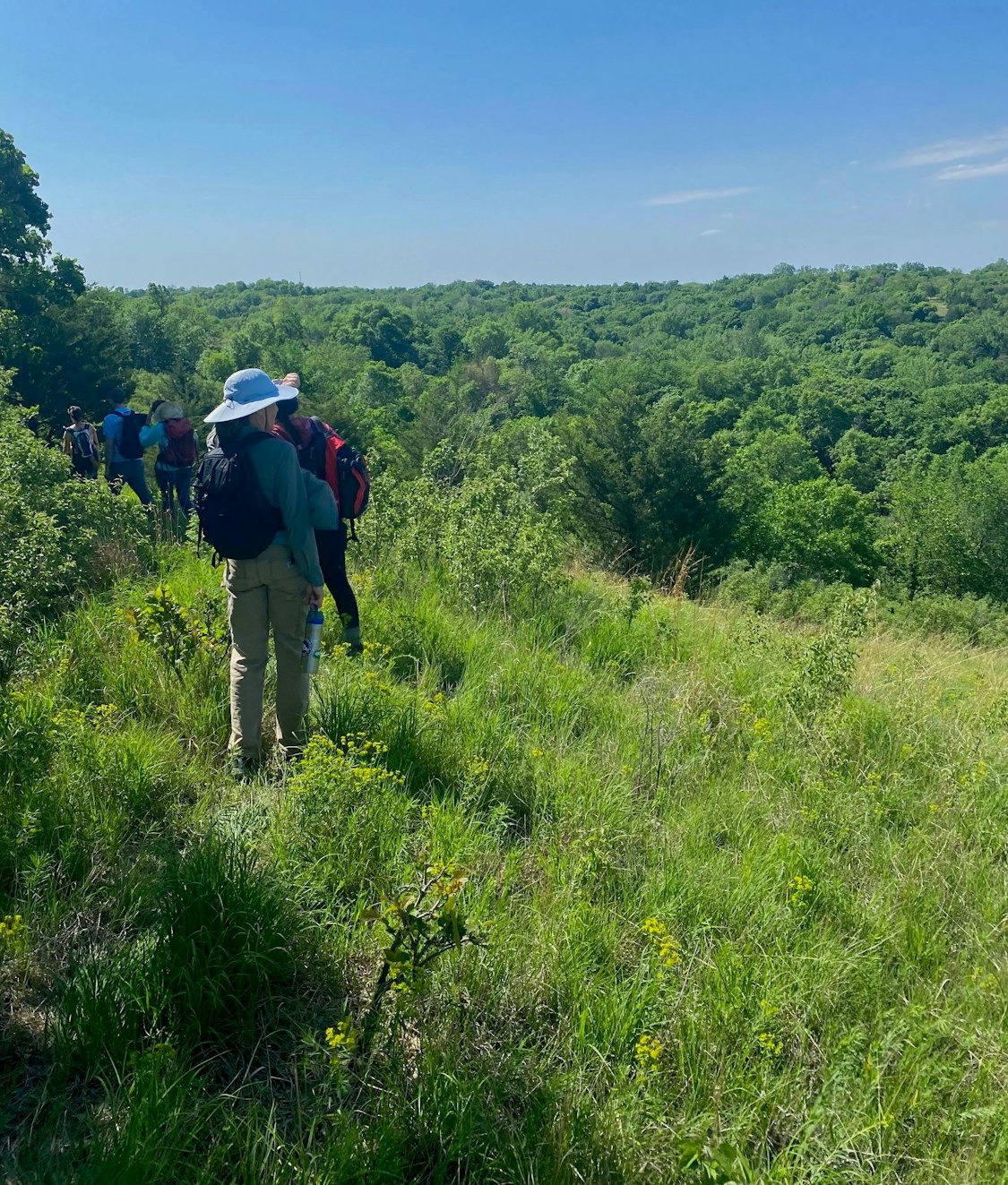
We were received for lunch by the local chapter of the Sierra Club at an iconic Civilian Conservation Corps-era picnic shelter in the park. Afterwards, we hit the trail and eventually found our way to the Dorothy Pecaut Nature Center, where we caught our rides back to the campsite.
Later that evening after dinner, the group gathered around the campfire to share what they had taken away from their experience. Some revealed their personal challenges, and expressed the feeling that walking in nature helped their mindset and eased their burden. This is the essence of the LoHi Trek motto: Solvitur ambulando, a Latin phrase that translates as “It is solved by walking.”
Another recurrent theme was the surprisingly rapid connection that developed between folks who hadn’t previously met, reviving hope that there remains a “human-kind”, and providing a welcome counterpoint to the divisiveness apparent in present-day society. It seems to me this community-building facet of the LoHi Trek suggests the motto of Solvitur ambulando should perhaps be joined with another Latin phrase Solvitur loquitur—“It is solved by talking” (especially over morning coffee!)—to capture the Trek’s full value to its participants.
When my turn came to speak, having quickly reflected on what had been said, I started by saying that I often think in metaphors, and felt compelled to ask the question: Why do we come to a native prairie to hike? After all, I supposed, we could (and did) hike through pastures dominated by invasive brome grass or walk through a cornfield.
My answer was that, while those other areas are green, they are monocultures and not very interesting to walk through. By contrast, the native prairie is diverse and interconnected, harboring so many different plants and animals whose lives intersect in various ways. That is why we hike here—because we are captivated by the prairie, and seek a deeper understanding of its inhabitants and mysteries.
I then said that everyone in the group is like a different species of native prairie plant, each unique and beautiful, each with something valuable to offer the larger community. So grow your roots deep, I said. Let your metaphorical flowers bloom so the rest of us can appreciate and benefit from the gifts they provide.
In the moment, of course, my words were not quite as seamless as my thoughts, and my thoughts were not fully complete.
In hindsight, I would have also added that the diverse Human Ecosystem created by the LoHi Trek is one thing that I appreciate seeing develop as an attendee, because it is not something I can watch or experience when I walk alone.
So to the LoHi Trek organizers, volunteers, hosts, and fellow hikers, and to the protectors and stewards of the Loess Hills landscape, thank you for your efforts to develop and sustain these diverse human and other-than-human ecosystems, and fostering their interplay in this amazing place.

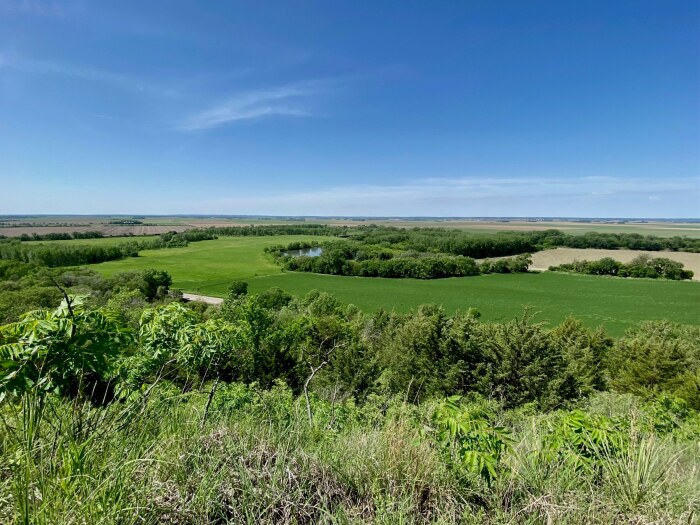
2 Comments
Thank you, everybody
Thank you, Patrick and Bleeding Heartland for this beautiful article and photos. Thanks too to all the conservationists working, patiently to preserve and share this remarkable landscape- the Nature Conservancy, Golden Hills RC&D, the Zales, the Sierra Club, Iowa DNR, Woodbury and Plymouth Counties Conservation boards and the bison.
miketram01 Thu 29 Jun 5:43 AM
An insightful response to a lovely essay with great photos
If a list were being made of the organizations working directly to protect the entire Loess Hills landscape, I would add the Iowa Natural Heritage Foundation. In terms of generally helping to ensure the future of the Hills, I’m grateful to those who help Iowans learn about the wonderfulness of prairies, and that includes a lot of naturalists, teachers, family members, and the Iowa Prairie Network.
PrairieFan Sat 1 Jul 2:04 PM